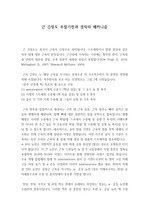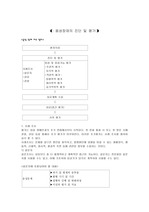

-
미리보기
소개
"근긴장도 조절기전 경직의 메카니즘"에 대한 내용입니다.목차
Ⅰ. 근 긴장도 조절기전과 경직의 메카니즘
Ⅱ. Spasticity mechanisms – for the clinician
1. spasticity mechanism
2. Mechanism of spasticity
3. Moter Control system
4. Motor functions of the Spinal Cord
5. Role of spinal excitatory mechanisms in spasticity
6. Role of Spinal Inhibitory Mechanisms in Spasticity
7. Supraspinal and Suprasegmental Mechanisms
8. Inhibitory supraspinal pathways
9. Excitatory Supraspinal pathways
Reference본문내용
근 긴장도는 휴식시 근육의 긴장으로 정의됩니다. 스트레칭이나 방향 변경과 같은 외부 힘에 대한 근육의 반응입니다. 근긴장에 기여하는 기전에는 항진된 반사, 근육힘줄 단위의 점탄성 성질, 수축 성분의 내재성 성질이 포함됩니다(De Vlugt 등, 2010; Mirbagheri 등, 2007; Sheean과 McGuire, 2009).
근육 긴장도 는 해당 근육을 자극하는 분절수준 의 국소척수반사 와 분절상 영향에 의해 조절됩니다. 척추반사를 보조 하는 신경회로는 그림 1에 나와있습니다.
(중추 신경계 쪽) 회로의 세 요소로 구성
(1) annulospiral 기계적 수용기 (핵낭 섬유) 및 그 유수 Ia 형 축삭
(2) 기계적 스트레칭 수용체 (핵 사슬 섬유) 및 유형 II 축삭
(3) 골지 건 기관 기계 수용체 및 그들의 유형 Ib 수초 축삭
근육 방추를 집합적으로 형성하는 근관 내 근육 섬유. 근육 방추는 뼈외 골격근 섬유와 평행하게 배향되며, 함께 뼈에 대한 일반적인 힘줄 부착으로 합쳐집니다. 평행 배열은 이러한 수용체가 근육 확장(꽃 스프레이 수용체 및 유형 II 축삭)의 이벤트뿐만 아니라 외 추근 섬유 의 수동신장 비율 (연륜 형 수용체 및 유형 Ia 축삭)을 인코딩 할 수 있도록 합니다. 대조적으로, 골지 힘줄 기관은 근육의 힘줄 부착 내에서 국소화로 인해 근육의 전체 질량과 직렬로 정렬됩니다. 이런 식으로 골지 건 기관은 수축하는 동안 주어진 근육의 총 힘에 의해 생성 된 힘줄의 스트레치를 암호화합니다.
α-모터 뉴런은 자발적인 운동을 위한 최종 공통 원심성 (발신) 경로로 오랫동안 인식되어 왔습니다. 이 큰 뉴런은 근육 스핀들의 Ia 및 II 구심성에서 직접 흥분성 접촉을 포함하여 20,000–50,000 시냅스 사이트를 통해 광범위한 시냅스 입력을 받습니다. 주요 억제 접점에서 발생 의 interneurons 골지 건 기관으로부터 Ib 형의 구심 의해 구동 피질 돌기 및 α-운동 신경과의 사이의 interneurons 렌쇼 세포.참고자료
· De Vlugt E, de Groot JH, Schenkeveld KE, et al. The relationbetween neuromechanical parameters and Ashworthscore in stroke patients. J Neuroeng Rehabil. 2010; 7:35.Do AH, Wang PT
· Mirbagheri MM, Settle K, Harvey R, et al. Neuromuscular abnormalities associated with spasticity of upperextremity muscles in hemiparetic stroke. J Neurophysiol.2007;98(2):629-37.
· Sheean G, McGuire JR. Spastic hypertonia and movementdisorders: pathophysiology, clinical presentation, andquantification. PM R. 2009;1(9):827-33.
· Burke, D., and Ashby, P. (1972). Are spinal ‘presynaptic’ inhibitory mechanisms suppressed in spascity? J. Neurol. Sci. 15, 321–326.
· Lance, J. W. (1980). “Symposium,” in Spasticity: Disordered Motor Control,
· eds R. G. Feldman, R. R. Young, and W.P. Koella (Chicago: Year Book MedicalPubs), 485–495.
· Young, R. R. (1989). Treatment of spastic patients. N. Engl. J. Med. 320, 1553–1555.
· Delwaide, P. J., and Gerard, P. (1993). “Reduction of non-reciprocal (lb)
· inhibition: a key factor for interpretingspastic muscle stiffness,” InternationalCongress on Stroke Rehabilitation, Berlin.
· Lundberg, A. (1979). Multisensory control of spinal reflex pathways. Prog. Brain Res. 50, 11–28.
· Schmidt, R. F. (1971). Presynaptic inhibition in the vertebrate central nervous system. Ergeb. Physiol. 63, 91–101.
· Rushworth, G. (1960). Spasticity and rigidity: an experimental study and review. J. Neurol. Neurosurg. Psychiatr. 23, 99–118.
· Hagbarth, K. E. (1981). “Fusimotor and stretch reflex functions studied in recordings from muscle spindle afferents in man,” in Muscle Receptors and Movement, Vol. 13. eds A. Taylor and A. Prochazka (New York: Oxford University Press), 109–115.
· Powers, R. K., and Binder, M. D. (2001). Input-output functions of mammalian motoneurons. Rev. Physiol. Biochem. Pharmacol. 143, 137–263. Hultborn, H., Brownstone, R. B., Toth, T. I., and Gossard, J. P. (2004). Key
· mechanisms for setting the inputoutput gain across the motoneuron pool. Prog. Brain Res. 143, 77–95.
· Heckmann, C. H., Gorassini, M. A., and Bennett, D. J. (2005). Persistent inward currents in motoneuron dendrites: implications for motor output. Muscle Nerve 31, 135–156.
· Liddell, E. G. T., and Sherrington, C. S. (1924). Reflexes in response to stretch (myotatic reflexes). Proc. R. Soc. 96B, 212–242.
· Delwaide, P. J., and Oliver, E. (1988). Shortlatency autogenic inhibition (lB) inhibition) in human spasticity. J. Neurol. Neurosurg. Psychiatr. 51, 1546–1550.
· Lundberg, A. (1975). “Control of spinal mechanism from the brain,” in The Nervous System, Vol. 1, eds D. Tower and R. Brady (New York: Raven Press), 253–265.
· Brooks, V. B. (1986). The Neural Basis of Motor Control. New York: Oxford University Press.
· Bucy, P. C., Kephnger, J. E., and Siqucira, E. B. (1964). Destruction of the pyramidal tract in man. J. Neurosurg. 21, 385–398.
· Fisher, C. M., and Curry, H. B. (1965). Pure motor hemiplegia of vascular
· origin. Arch. Neurol. 13, 30–44.
· Schreiner, L. M., Mandsley, D. B., and Magoum, H. W. (1949). Role of brain stem facilitatory systems in maintenance of spasticity. Neurophysiology 12, 207–216.
· Shahani, B. T., and Young, R. R. (1973). “Human flexor spasm,” in New Developments in Electromyography and Clinical Neurophysiology, Vol. 3, ed J. E. Desmedt (Basal: S Karger AG), 734–743.태그
-
자료후기
Ai 리뷰이 자료는 깊이 있는 설명과 다양한 예시 덕분에 과제를 작성하는 데 큰 도움이 되었습니다. 앞으로도 이런 유익한 자료가 계속 등록되기를 바랍니다! -
자주묻는질문의 답변을 확인해 주세요

꼭 알아주세요
-
자료의 정보 및 내용의 진실성에 대하여 해피캠퍼스는 보증하지 않으며, 해당 정보 및 게시물 저작권과 기타 법적 책임은 자료 등록자에게 있습니다.
자료 및 게시물 내용의 불법적 이용, 무단 전재∙배포는 금지되어 있습니다.
저작권침해, 명예훼손 등 분쟁 요소 발견 시 고객센터의 저작권침해 신고센터를 이용해 주시기 바랍니다. -
해피캠퍼스는 구매자와 판매자 모두가 만족하는 서비스가 되도록 노력하고 있으며, 아래의 4가지 자료환불 조건을 꼭 확인해주시기 바랍니다.
파일오류 중복자료 저작권 없음 설명과 실제 내용 불일치 파일의 다운로드가 제대로 되지 않거나 파일형식에 맞는 프로그램으로 정상 작동하지 않는 경우 다른 자료와 70% 이상 내용이 일치하는 경우 (중복임을 확인할 수 있는 근거 필요함) 인터넷의 다른 사이트, 연구기관, 학교, 서적 등의 자료를 도용한 경우 자료의 설명과 실제 자료의 내용이 일치하지 않는 경우
찾으시던 자료가 아닌가요?
지금 보는 자료와 연관되어 있어요!
문서 초안을 생성해주는 EasyAI



